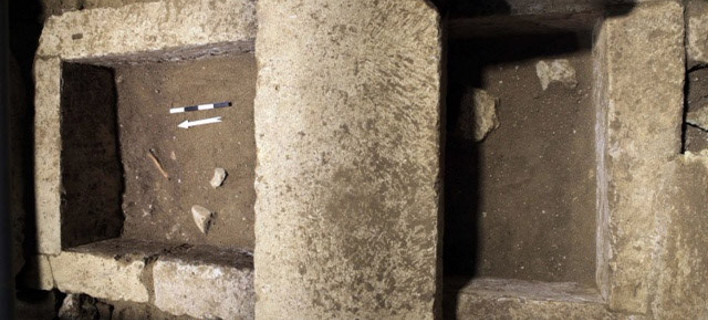"The excavation of the tomb was the best Kasta scientific way, We have an amazing Tomb. A big thank you to all those who gave their souls for this excavation, from the Ministry of culture until the last employee, and beyond that I want to thank the Rector of the Aristotle University of Thessaloniki, He came to our team, and Gregory Tsoka to continue the fight and our work on the Tomb. The excavation has not stopped, We will continue because our yard still preserves many secrets», the archaeologist Caterina Peristeri said during a recent press conference.
From the perspective of the Culture Ministry's General Secretary Lina Mendoni stated that "with the revelation of kibwtioschimoy tomb and skeleton of dead ends this phase of archaeological research. Left a lot to be done for the overall monument which covers the Tumulus Kasta. We are really glad that such an important monument added to the puzzle of history and archaeology of the region. It is very important for the region that such a finding, such an important monument comes to connect with all the other rich finds from the area, forming and filling a very important development resource for the entire Macedonia and country».
The Rector of the Aristotle University of Thessaloniki Pericles Mitkas said that "the UNIVERSITY raised the first time the entire scientific arsenal at the disposal of excavation in Amphipolis. We are delighted that it has chosen the workshop of applied Geophysics to do appropriate investigations of electrical prospecting in Kasta Hill. We will cover the costs of the investigation on the height of 12.000 euro and hopefully will announce and other useful findings in Hill Kasta ".
The Director of the laboratory of applied Geophysics, Professor Gregory Tsokas, He pointed out that the Department will implement the method of electrical resonance which will give them the electrical ground Imaging. He mentioned that "this method has contributed to a decisive role by making known my lab on a global scale and has been awarded for it».
NOTES
1. Source: ANA-MPA ((A). Tapaskoy).
archaiologia.gr
 MISIS, TURKEY—An enduring history is being revealed in southern Turkey at the ancient site of Misis, reports Hurriet Daily News. Located on the Silk Road, Misis was first settled some time in the fifth millennium B.C. during the Neolithic period, and, according to Giovanni Salmeri of Pisa University, who is leading the excavations, has been host to various civilizations including Chalcolithic, Hittite, Roman, and Byzantine settlements over its millennia-long history. Thus far Salmeri's team has uncovered innumerable artifacts and impressive examples of monumental architecture—including a stone bridge, aqueduct, a city bath, tombs, and a Byzantine caravanserai—some of which were decorated with mosaics. The excavated material from Misis will be housed in the Misis Mosaic Museum along with a large mosaic that was discovered when the first digs were undertaken by German archaeologists on the 1950s. To read more about Turkey fantastic Roman mosaics, go to “Zeugma After the Flood.”
MISIS, TURKEY—An enduring history is being revealed in southern Turkey at the ancient site of Misis, reports Hurriet Daily News. Located on the Silk Road, Misis was first settled some time in the fifth millennium B.C. during the Neolithic period, and, according to Giovanni Salmeri of Pisa University, who is leading the excavations, has been host to various civilizations including Chalcolithic, Hittite, Roman, and Byzantine settlements over its millennia-long history. Thus far Salmeri's team has uncovered innumerable artifacts and impressive examples of monumental architecture—including a stone bridge, aqueduct, a city bath, tombs, and a Byzantine caravanserai—some of which were decorated with mosaics. The excavated material from Misis will be housed in the Misis Mosaic Museum along with a large mosaic that was discovered when the first digs were undertaken by German archaeologists on the 1950s. To read more about Turkey fantastic Roman mosaics, go to “Zeugma After the Flood.” 


























